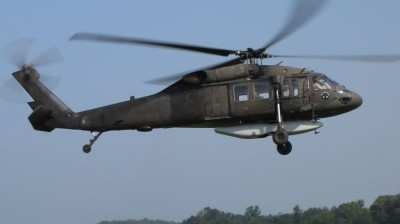Wed, Feb 10, 2010
Airborne System Designed To Protect U.S. Army Ground
Troops
The initial flight test of a new, real-time persistent
surveillance capability allowing U.S. combat forces to detect,
locate, track and monitor events on battlefields and in urban areas
has been completed, BAE Systems announced Monday.

The first flight tests of the Autonomous Real-Time Ground
Ubiquitous Surveillance Imaging System, or ARGUS-IS, occurred
aboard a U.S. Army Black Hawk helicopter. The tests demonstrated
the system’s multiple video windows for persistent area
surveillance and tracking capabilities for vehicles and dismounted
soldiers. BAE says the new system provides significantly improved
video coverage over current airborne capabilities.
The airborne processing system can simultaneously and
continuously detect and track the presence and motion of thousands
of small or large targets over an area covering tens of square
miles. BAE Systems designed and produced the system’s sensor
and processor.
“ARGUS-IS will significantly advance the Army’s
capability to protect its troops through improved search and
surveillance capabilities,” said Dr. John Antoniades, ARGUS
program manager and director of remote sensing technology for BAE
Systems.
 BAE Systems equipment aboard
ARGUS-IS consists of a high-resolution, extreme wide-area,
real-time video sensor; an on-board processing system; and ground
processing for interactive multi-target designation, tracking, and
exploitation.
BAE Systems equipment aboard
ARGUS-IS consists of a high-resolution, extreme wide-area,
real-time video sensor; an on-board processing system; and ground
processing for interactive multi-target designation, tracking, and
exploitation.
“The ARGUS-IS system overcomes the fundamental limitations
of current airborne surveillance systems,” said Dr. Steven
Wein, director of optical sensor systems at BAE Systems.
“Very high-resolution imaging systems required for vehicle
and dismount tracking typically have a ‘soda-straw’
view that is too small for persistent coverage. Existing wide-area
systems have either inadequate resolution or require multiple
passes or revisits to get updates.”
The Defense Advanced Research Projects Agency and the Air Force
Research Laboratory awarded BAE Systems an initial $18.5 million
contract to lead the ARGUS-IS effort in late 2007. The system is
targeted for use in Department of Defense unmanned and manned
surveillance platforms.
More News
After Draining Both Wing Fuel Tanks, A Significant Amount Of Water Was Observed In The Right Wing Fuel Tank Analysis: The pilot, who was also the owner of the experimental amateur->[...]
“Airbus apologises for any challenges and delays caused to passengers and airlines by this event. The Company thanks its customers, the authorities, its employees and all rel>[...]
High Speed Taxiway A long radius taxiway designed and provided with lighting or marking to define the path of aircraft, traveling at high speed (up to 60 knots), from the runway ce>[...]
Aero Linx: Taylorcraft Foundation, Inc. The Taylorcraft Foundation is exclusively organized for charitable, educational & scientific activities and will preserve the history an>[...]
Also: USAF Reaper Accident, Baikonur Damage, Horizon eVTOL IFR/FIKI, New Glenn Update Honda has outlined its clearest timeline yet for its entry into the world of electric vertical>[...]
 NTSB Final Report: Patriot Aircraft LLC CX1900A
NTSB Final Report: Patriot Aircraft LLC CX1900A Aero-News: Quote of the Day (12.06.25)
Aero-News: Quote of the Day (12.06.25) ANN's Daily Aero-Term (12.06.25): High Speed Taxiway
ANN's Daily Aero-Term (12.06.25): High Speed Taxiway ANN's Daily Aero-Linx (12.06.25)
ANN's Daily Aero-Linx (12.06.25) Airborne-NextGen 12.02.25: Honda eVTOL, Arctus High-Alt UAS, Samson Patent
Airborne-NextGen 12.02.25: Honda eVTOL, Arctus High-Alt UAS, Samson Patent



